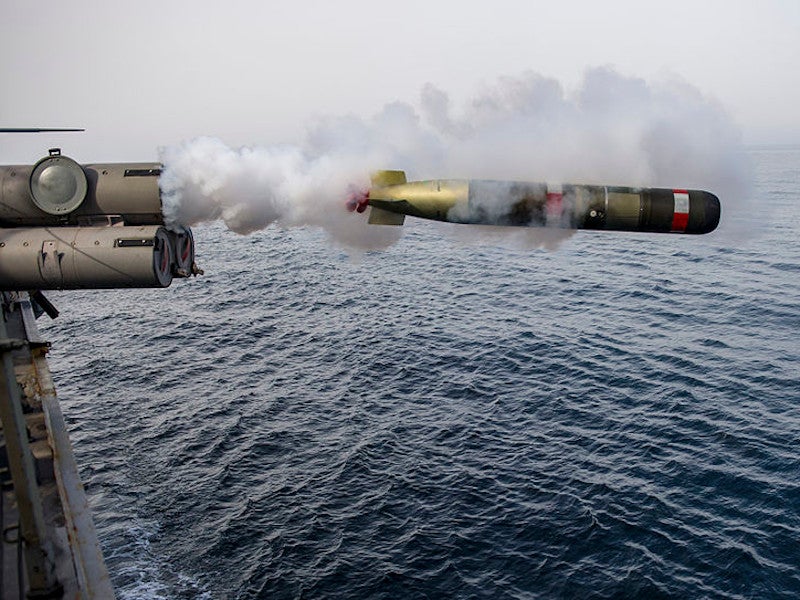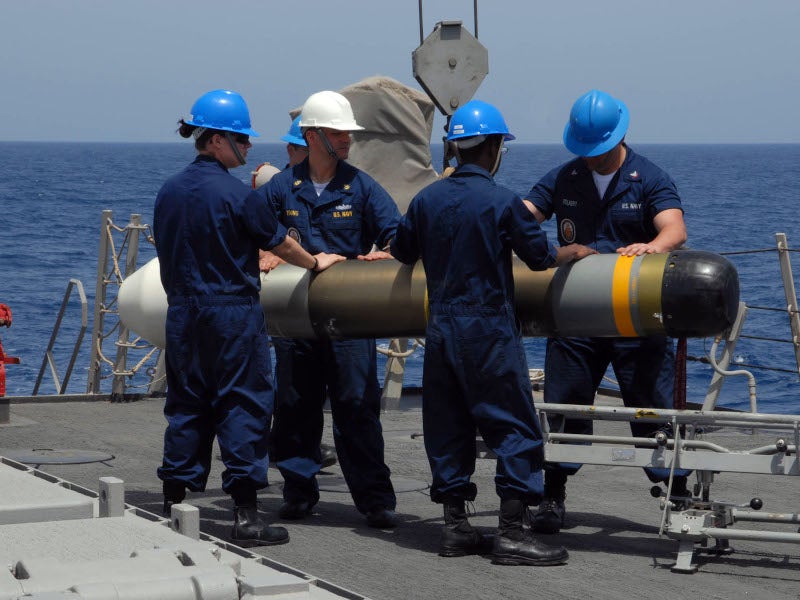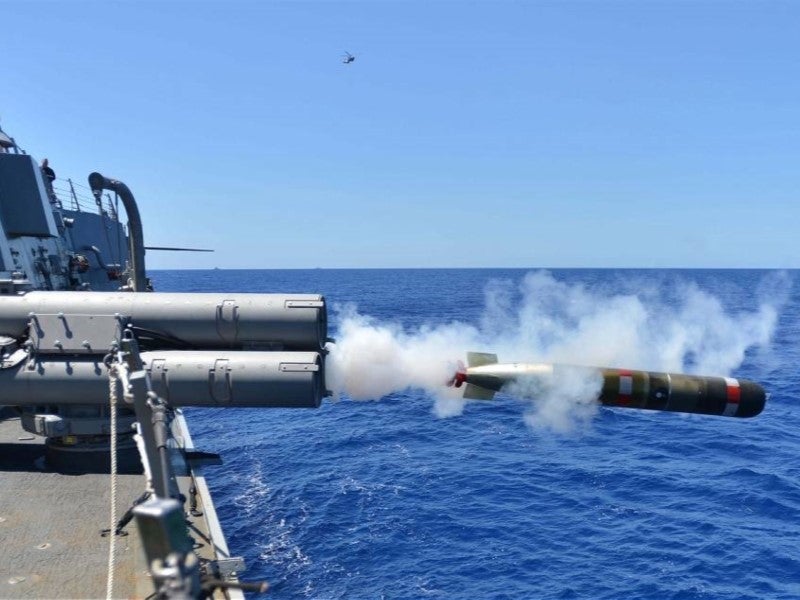MK 54 is an advanced lightweight torpedo designed and developed by Raytheon Integrated Defense Systems in collaboration with the US Navy. It was previously known as the Lightweight Hybrid Torpedo (LHT).
The anti-submarine warfare torpedo is used in both deep and shallow waters, as well as in acoustic environments. It is capable of tracking, classifying and attacking underwater targets.
Designed for launch from surface ships, fixed-wing aircraft and helicopters, MK 54 replaced the US Navy’s Mark 46 torpedo. The ability to operate in both littoral and deep-water environments enables the torpedo to hit any target irrespective of water depth.
In addition to the US Navy, the torpedo is used by the Indian Navy, the Royal Australian Navy, the Royal Air Force and the Royal Thai Navy. It is also in operation in countries including Australia, New Zealand, Canada, Germany and the Netherlands.
MK 54 lightweight torpedo development
The US Navy intended to develop an advanced lightweight hybrid torpedo (LHT) for the replacement of its Mark 46 torpedo. A successful critical design review was performed in November 1999 after developmental testing began in July 1999. Raytheon won a sole source contract to produce the MK 54 torpedo in April 2003.
The company commenced full-rate production of the torpedo under the Navy’s LHT programme in October 2004. The five-year contract, valued at more than $500m, included the delivery of 51 MK54 lightweight torpedoes and related support services throughout the lifecycle. The torpedo achieved initial operational capability (IOC) in 2004, while the Vertically Launched ASW Rocket (ASROC) (VLA) system attained IOC in 2010.
MK 54 Mod 1 torpedo development details
The US Navy embarked on upgrading the torpedo and began development of MK 54 Mod 1 torpedo in 2007, followed by in-water developmental testing in November 2015. It continued with the development of MK 54 Mod 1 torpedo sonar section hardware and tactical software in 2017 to overcome previously identified issues.
The production of the MK 54 Mod 0 version ceased in 2020.
As an Acquisition Category (ACAT) III programme, Mod 1 has two increments: Increment 1 comprising Advanced Processor Build 5 software for improved target detection and Increment 2 to include additional updates focused on improved performance with a set of scenarios.
The US Navy achieved the IOC for the MK 54 Mod 1 in 2023. The MK 54 Mod 1 entered full-rate production in April 2023.
The US Navy aims to submit the Test and Evaluation Master Plan (TEMP) update for Mod 1 Increment 2 in the second quarter of 2025 and begin follow-on operational test and evaluation in the first quarter of 2026.
MK 54 Mod 2 torpedo development
The Mk 54 Mod 2 is an ACAT IB programme and a collaborative development project with Australia. The director, operational test and evaluation (DOT&E) sanctioned the Mod 2 Milestone B Joint TEMP in January 2023.
The joint TEMP mandates in-water set-to-hit tests. The US Navy intends to commence initial operation testing and evaluation for the Mk 54 Mod 2 in 2027.
Design and features of MK 54 lightweight torpedo
The MK 54 lightweight torpedo includes hardware and software features of the Mk 46, Mk 50 and Mk 48 torpedoes coupled with commercial off-the-shelf technology to provide improved ability to tackle shallow-water countermeasures.
MK 54 torpedoes are equipped with processing algorithms that help them detect false targets or countermeasures and then hunt the identified threats. The torpedo has a length of 2.71m, a diameter of 32.3cm and a weight of 275.7kg. The warhead carried by the weapon is highly explosive and weighs 43.9kg.
The TG-6000 inertial measurement unit (IMU) guidance system is integrated into the torpedo for accurate three-dimensional measurement of motion and acceleration. The active or passive acoustic homing system is fitted to the torpedo for guidance capabilities.
The modernisation of the MK 54 will include upgrades to hardware and software to significantly enhance the probability of kill-and-meet, changing threats in the littoral environment.
Propulsion
The MK 54 lightweight torpedo is powered by a reciprocating external combustion engine, which burns Otto II liquid fuel.
The propulsion system allows the torpedo to cruise at a speed of 74.1km/h.
Contractors involved in MK 54 lightweight torpedo programme
KVH Industries received the first production order from Raytheon for a fibre-optic gyro-based TG-6000 precision IMU for use in the guidance system of the MK 54, in October 2003. It was awarded a follow-on order in 2005.
Northrop Grumman received a $45.9m contract from the US Navy in August 2013 to produce MK54 torpedo acoustic nose arrays.
In October 2018, Ultra Electronics secured a $42.1m contract from the US Naval Sea Systems Command to manufacture and supply MK54 Mod 0 torpedo array kits and associated spares. The contract also included the delivery of engineering and hardware repair services.
The US Navy awarded another transaction authority contract to Aerojet Rocketdyne, a subsidiary of L3Harris, for the development of a new propulsion system for the MK 54 Mod 2 in February 2020. The contract included the development of a prototype stored chemical energy propulsion system power plant and afterbody/tail cone for integration into the Mod 2 advanced lightweight torpedo.
In September 2021, Ultra Electronics Ocean Systems secured a $23m contract to produce MK54 Mod 0 lightweight torpedo array kits and provide support services, with combined purchases for Belgium, Brazil, the Netherlands, New Zealand, Spain and the US.
In August 2022, the US Navy awarded a contract to Boeing to produce High Altitude Anti-Submarine Warfare Weapon Capability, an add-on kit enabling MK 54 torpedo to be launched near or below the cruising altitude from Boeing’s P-8A Poseidon.
Aerojet Rocketdyne was contracted to supply the afterbody, propulsion system and tail for the new Compact Rapid Attack Weapon in October 2023. The new torpedo will use the new Stored Chemical Energy Propulsion System, which is expected to improve its capabilities.
Orders and deliveries
The Australian government placed an order for the procurement of 200 additional MK 54 torpedoes for its navy. The weapon is air-launched from the Royal Australian Navy’s MH-60R ASW helicopters. The Royal Australian Navy placed an $83m order for up to 100 MK 54 all-up-round torpedoes in July 2013.
Raytheon secured multiple contracts, including an August 2016 agreement to supply the US Navy and Thailand with torpedo common parts kits, MK 54 Mod 0 lightweight torpedo kits and related equipment valued at $37m. A contract modification in the same year for $29.7m enabled the production of kits for the US Navy and the sale of kits to India, Australia and Turkey for torpedo upgrades.
The US government sanctioned the sale of 16 MK 54 lightweight torpedoes and three exercise torpedoes to India in April 2020 under a deal worth $63m. The UK Royal Air Force’s P-8A Poseidon maritime patrol aircraft are also equipped with Mk 54 torpedoes.
Canada’s request for the procurement of 425 torpedo conversion kits was approved by the US government in May 2019.
In July 2020, the US State Department approved a $130m foreign military sale (FMS) of 64 MK 54 torpedoes, ten conversion kits and related equipment to Germany.
In the same year, Raytheon was awarded an $88m contract from the US Department of Defense to produce MK54 Mod 0 and Mod 1 common part kits and spare torpedo components. As a modification contract, it included a combined purchase for the US Navy and Canada, South Korea, Denmark, Australia and Spain under a foreign military sales (FMS) programme.
In December of the same year, the State Department approved the FMS of MK 54 torpedoes and related equipment to Brazil, for $70m.
Brazil requested to buy 22 MK 54 conversion kits to convert MK 46 Mod 5 A(S) torpedoes to MK 54 Mod 0 torpedoes.
In July 2022, the US State Department approved a sale of 31 MK 54 torpedoes along with additional equipment to the Republic of Korea, for $130m.
In December 2023, a $300m sale of 80 MK 54 torpedoes and related equipment was approved by the US government to Germany.







